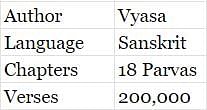History: CUET Mock Test - 2 - CUET MCQ
30 Questions MCQ Test CUET Mock Test Series - History: CUET Mock Test - 2
Mahatma Gandhi wanted to make ____ language as the national language.
| 1 Crore+ students have signed up on EduRev. Have you? Download the App |
Which of the following was not one of the barriers as discussed by Al-Biruni?
What were the guilds of the merchants and craftsmen called?
According to Shastras, only __ could rule the country.
When did Mahatma Gandhi make his major public appearance?
Which of these sites of Harappan Civilisation belong to Haryana?
Who gave us the most important description of Vijayanagara in the 15th century?
Which of these was the most powerful Mahajanapada from the 6th to 4th century BCE?
Which of the following cities, according to Ibn-Battuta, was the largest?
Which of these cities was not the capital of the Mughal Court?
It was a scriptorium where the emperor’s collection of manuscripts was preserved:
Name the languages in which the Ashokan inscriptions were written.
What was the main feature of the Harappa Civilisation?
Which of these was the source of copper for Harappans?
Which town in Indus Valley Civilisation had no Citadel?
Who made Persian as the Court language of the Mughal Court?
|
8 docs|148 tests
|


















